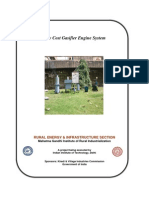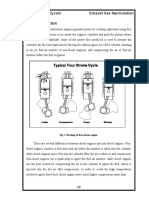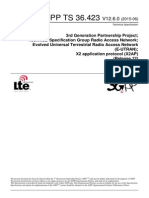Cai Engines
Cai Engines
Uploaded by
manavkumarsinghCopyright:
Available Formats
Cai Engines
Cai Engines
Uploaded by
manavkumarsinghCopyright
Available Formats
Share this document
Did you find this document useful?
Is this content inappropriate?
Copyright:
Available Formats
Cai Engines
Cai Engines
Uploaded by
manavkumarsinghCopyright:
Available Formats
PRESNTED BY: PRADEEP CHANDRA ROLL NO.
123613
CAI
is abbreviation of Controlled Auto ignition.
Controlled
auto-ignition (CAI) combustion technique is a newly developed low engine emission technology. first attempts to utilize CAI combustion were made to control irregular and misfiring combustion in 2-stroke SI engines at light loads by Japanese researchers during late 1970s.
The
One
of the first reported works in CAI is attributed to Onishi et al. They developed a new technique, called Active Thermo-Atmosphere Combustion (ATAC). phenomenon of auto ignition, the curse of old petrol engines, is used here to cause instant ignition of the whole air-fuel mixture in the combustion chamber.
The
It
involves the auto-ignition and simultaneous combustion of a homogeneous air-fuel mixture. this chemical kinematics process is characterized by absence of flame propagation. heat release rate.
In
Rapid
To To In
reduce greenhouse gas such as CO2 . reduce NOx level in automobile exhaust.
order to cope with strengthened global emission standards such as the SULEV (super ultra-low emission vehicle). In order to meet CAFE (corporate average fuel economy) and the Kyoto Protocol, the demands for better fuel efficiency and lower emissions levels increased in the automotive industry.
1.
Exhaust gas recirculation (EGR): using the trapped exhaust gas recirculation. Direct intake charge heating: heating the intake port. Higher compression ratio: increasing the compression ratio with changing the piston cavity.
2.
3.
There 1.
are two methods to obtained EGR:
Direct supply of exhaust gas to inlet manifold.
2.
Using negative valve overlap.
negative valve overlap period is used to retain high amount of residual gases in the cylinder. The exhaust valve is closed before the piston reaches top dead centre in the exhaust stroke and to prevent backflow of the burned gases in the intake system. The intake valves open well after TDC.
The CAI region is enveloped by three engine operation regimes viz.
1.
Engine knock: It is experienced as increases. The knock limited increases as the rate of EGR increases. Misfire: Engine misfire of the charge results as EGR is increased and the engine bmep is decreased.
2.
3.
Partial burning: For the fuel-air equivalence ratio less than about 0.2. As the fuel-air equivalence ration decreases, the heat released also decreases lowering the average combustion temperature resulting in partial burn.
Total
engine speed-load operation regime with the present status of development in CAI operation are:
Effective
operating engine speed using CAI from1000 to 3500 rpm .
1000 rpm, knock free CAI operation using EGR is possible up to about 4 bar bmep that reduces to nearly 2.5 bar bmep at 3500 rpm.
At
On
the other hand the SI engine full load bmep is about 10 bar. and the rated engine speed typically is around 6000-7000 rpm.
The
practical engines could be operated in mixed CAI-SI mode. At low and medium loads and at vehicle cruising speeds engine operates in CAI mode but during cold starting, at idling and at high load and speeds the engine operates in conventional SI mode.
The emissions from an SI engine that operated in CAI mode at part loads are compared with the homogeneous stoichiometric SI engine using following: Negative valve overlap ranging from 140-200 crank angle for CAI operation. Residual gas fraction varied from 40 to 70%. The intake air temperature was increased to 50 C by external heating.
The 1.
following results are obtained using CAI:
2.
3. 4.
NOx emissions with CAI operation are extremely low. HC emissions were higher as use of very lean mixtures results in partial misfired combustion increasing HC emissions. CO emissions decreased by 80 %. The fuel consumption was lower by 15% at engine speeds of above 2000 rpm.
CAI
provides up to a 15-percent fuel savings, while meeting current emissions standards. CAI engines are fuel-lean, they can operate at a Diesel-like compression ratios (>15), thus achieving higher efficiencies than conventional spark-ignited gasoline engines.
Since
The
omission of throttle losses improves CAI efficiency.
Homogeneous
mixing of fuel and air leads to cleaner combustion and lower emissions. Actually, because peak temperatures are significantly lower than in typical spark ignited engines, Nox levels are almost negligible. engines can operate on gasoline, and most alternative fuels.
CAI
High
in-cylinder peak pressures may cause damage to the engine. heat release and pressure rise rates contribute to engine wear. engines have a small power range, constrained at low loads by lean flammability limits and high loads by in-cylinder pressure restrictions.
High
CAI
The
autoignition event is difficult to control, unlike the ignition event in spark ignition (SI) engines which is controlled by spark plugs
Hydrocarbon
(HC) pre-catalyst emissions are higher than a typical spark ignition engine, caused by incomplete oxidation (due to the rapid combustion event and low in-cylinder temperatures).
In
2007-2009, General Motors has demonstrated CAI with a modified 2.2 L engine installed in Opel Vectra and Saturn Aura. The engine operates in CAI mode at speeds below 60 miles per hour (97 km/h) or when cruising, switching to conventional spark-ignition when the throttle is opened, and produces fuel economy of 43 miles per imperial gallon (6.6 L/100 km) and carbon dioxide emissions of about 150 grams per kilometre, improving on 37 miles per imperial gallon (7.6 L/100 km) and 180 g/km of the conventional 2.2 L direct injection version.
Mercedes-Benz
has developed a prototype engine called DiesOtto, with controlled auto ignition. Volkswagen is developing engine for CAI operation called Gasoline Compression Ignition or GCI; it uses CAI when cruising and spark ignition when accelerating. This engine have been demonstrated in Touran prototypes, and the company expects them to be ready for production in about 2015.
Combustion
engines by Prof. BP Pundir , Department Mechanical Engineering IIT Kanpur. An experimental study of fuel injection strategies in CAI gasoline engine by J. Hunicz *, P. Kordos. www.combustion.com
You might also like
- Ipedex Instrumentation Training Modules PDF67% (3)Ipedex Instrumentation Training Modules PDF921 pages
- Lab Session # 10: 10.0 Emission Control Technique Principle Vehicle EmissionsNo ratings yetLab Session # 10: 10.0 Emission Control Technique Principle Vehicle Emissions6 pages
- 2016 Aachen Conti Super Clean Diesel V10No ratings yet2016 Aachen Conti Super Clean Diesel V1032 pages
- Homogeneous Charge Compression Ignition EnginehcciNo ratings yetHomogeneous Charge Compression Ignition Enginehcci36 pages
- Homogeneous Charge Compression Ignition EnginehcciNo ratings yetHomogeneous Charge Compression Ignition Enginehcci36 pages
- Homogeneous Charge Compression Ignition HCCI Engine-PresentationNo ratings yetHomogeneous Charge Compression Ignition HCCI Engine-Presentation37 pages
- Less Emissions Through Waste Heat RecoveryNo ratings yetLess Emissions Through Waste Heat Recovery10 pages
- Literature: (ISSN 2250-2459, ISO 9001:2008 Certified Journal, Strategies of Combustion Control For HCCI Engine100% (1)Literature: (ISSN 2250-2459, ISO 9001:2008 Certified Journal, Strategies of Combustion Control For HCCI Engine34 pages
- In Internal Combustion Engines, Exhaust Gas Recirculation (EGR) Is ANo ratings yetIn Internal Combustion Engines, Exhaust Gas Recirculation (EGR) Is A10 pages
- MTU White Paper Exhaust Gas RecirculationNo ratings yetMTU White Paper Exhaust Gas Recirculation4 pages
- Iaetsd Evaluation of Performance and Emission Characteristics of LHRNo ratings yetIaetsd Evaluation of Performance and Emission Characteristics of LHR6 pages
- Review On Homogeneous Charge Compression IgnitionNo ratings yetReview On Homogeneous Charge Compression Ignition11 pages
- Gas Turbines: Joule (Constant Pressure) CycleNo ratings yetGas Turbines: Joule (Constant Pressure) Cycle3 pages
- Increasing The Efficiency of A Two-Stroke Car Diesel EngineNo ratings yetIncreasing The Efficiency of A Two-Stroke Car Diesel Engine4 pages
- Homogeneous Charge Compression Ignition (HCCI) EnginesNo ratings yetHomogeneous Charge Compression Ignition (HCCI) Engines36 pages
- Technical Specifications & Feature List: Mahindra ScorpioNo ratings yetTechnical Specifications & Feature List: Mahindra Scorpio5 pages
- Gas-Engines and Producer-Gas Plants A Practice Treatise Setting Forth the Principles of Gas-Engines and Producer Design, the Selection and Installation of an Engine, Conditions of Perfect Operation, Producer-Gas Engines and Their Possibilities, the Care of Gas-Engines and Producer-Gas Plants, with a Chapter on Volatile Hydrocarbon and Oil EnginesFrom EverandGas-Engines and Producer-Gas Plants A Practice Treatise Setting Forth the Principles of Gas-Engines and Producer Design, the Selection and Installation of an Engine, Conditions of Perfect Operation, Producer-Gas Engines and Their Possibilities, the Care of Gas-Engines and Producer-Gas Plants, with a Chapter on Volatile Hydrocarbon and Oil EnginesNo ratings yet
- MG Midget & A-H Sprite: Your expert guide to common problems & how to fix themFrom EverandMG Midget & A-H Sprite: Your expert guide to common problems & how to fix themNo ratings yet
- How to Power Tune Harley Davidson 1340 Evolution Engines: For Road & TrackFrom EverandHow to Power Tune Harley Davidson 1340 Evolution Engines: For Road & TrackNo ratings yet
- The Ultimate Network Monitoring ChecklistNo ratings yetThe Ultimate Network Monitoring Checklist2 pages
- Gartner's Research 7 Actions Enterprise Architecture Leaders Must Take To Navigate Economic HeadwindsNo ratings yetGartner's Research 7 Actions Enterprise Architecture Leaders Must Take To Navigate Economic Headwinds12 pages
- Presentation On A Literature Review On IoT-based Smart Poultry FarmingNo ratings yetPresentation On A Literature Review On IoT-based Smart Poultry Farming44 pages
- 6H1307 Kodak CR-ITX 560 INSTALLATION - MAY2009No ratings yet6H1307 Kodak CR-ITX 560 INSTALLATION - MAY200992 pages
- Integrated Cad/Cam For The Sheet Metal Industry: Master Your Manufacturing ProcessNo ratings yetIntegrated Cad/Cam For The Sheet Metal Industry: Master Your Manufacturing Process8 pages
- Lab Session # 10: 10.0 Emission Control Technique Principle Vehicle EmissionsLab Session # 10: 10.0 Emission Control Technique Principle Vehicle Emissions
- Homogeneous Charge Compression Ignition EnginehcciHomogeneous Charge Compression Ignition Enginehcci
- Homogeneous Charge Compression Ignition EnginehcciHomogeneous Charge Compression Ignition Enginehcci
- Homogeneous Charge Compression Ignition HCCI Engine-PresentationHomogeneous Charge Compression Ignition HCCI Engine-Presentation
- Literature: (ISSN 2250-2459, ISO 9001:2008 Certified Journal, Strategies of Combustion Control For HCCI EngineLiterature: (ISSN 2250-2459, ISO 9001:2008 Certified Journal, Strategies of Combustion Control For HCCI Engine
- In Internal Combustion Engines, Exhaust Gas Recirculation (EGR) Is AIn Internal Combustion Engines, Exhaust Gas Recirculation (EGR) Is A
- Iaetsd Evaluation of Performance and Emission Characteristics of LHRIaetsd Evaluation of Performance and Emission Characteristics of LHR
- Increasing The Efficiency of A Two-Stroke Car Diesel EngineIncreasing The Efficiency of A Two-Stroke Car Diesel Engine
- Homogeneous Charge Compression Ignition (HCCI) EnginesHomogeneous Charge Compression Ignition (HCCI) Engines
- Technical Specifications & Feature List: Mahindra ScorpioTechnical Specifications & Feature List: Mahindra Scorpio
- Gas-Engines and Producer-Gas Plants A Practice Treatise Setting Forth the Principles of Gas-Engines and Producer Design, the Selection and Installation of an Engine, Conditions of Perfect Operation, Producer-Gas Engines and Their Possibilities, the Care of Gas-Engines and Producer-Gas Plants, with a Chapter on Volatile Hydrocarbon and Oil EnginesFrom EverandGas-Engines and Producer-Gas Plants A Practice Treatise Setting Forth the Principles of Gas-Engines and Producer Design, the Selection and Installation of an Engine, Conditions of Perfect Operation, Producer-Gas Engines and Their Possibilities, the Care of Gas-Engines and Producer-Gas Plants, with a Chapter on Volatile Hydrocarbon and Oil Engines
- MG Midget & A-H Sprite: Your expert guide to common problems & how to fix themFrom EverandMG Midget & A-H Sprite: Your expert guide to common problems & how to fix them
- Utilizing Vegetable Oils for Biofuel GenerationFrom EverandUtilizing Vegetable Oils for Biofuel Generation
- How To Power Tune Jaguar XK 3.4, 3.8 & 4.2 Litre EnginesFrom EverandHow To Power Tune Jaguar XK 3.4, 3.8 & 4.2 Litre Engines
- How to Power Tune Harley Davidson 1340 Evolution Engines: For Road & TrackFrom EverandHow to Power Tune Harley Davidson 1340 Evolution Engines: For Road & Track
- Gartner's Research 7 Actions Enterprise Architecture Leaders Must Take To Navigate Economic HeadwindsGartner's Research 7 Actions Enterprise Architecture Leaders Must Take To Navigate Economic Headwinds
- Presentation On A Literature Review On IoT-based Smart Poultry FarmingPresentation On A Literature Review On IoT-based Smart Poultry Farming
- Integrated Cad/Cam For The Sheet Metal Industry: Master Your Manufacturing ProcessIntegrated Cad/Cam For The Sheet Metal Industry: Master Your Manufacturing Process

























































































